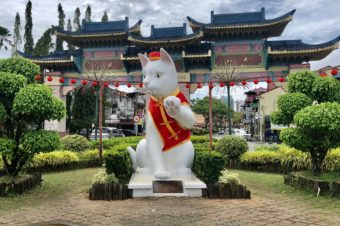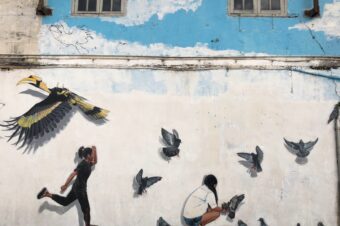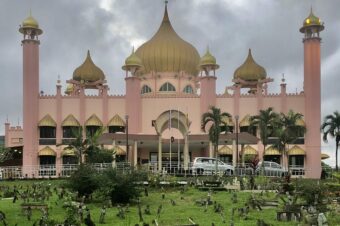While I was in Peninsular Malaysia, I found a cheap flight to Malaysian Borneo. I hadn't planned on going but who can resist visiting Borneo? As soon as I clicked 'purchase', I was excited at the prospect of seeing orangutans and Proboscis monkeys in the wild.
I found two places where to see orangutans in Sarawak, Malaysian Borneo: Sepilok Orangutan Rehabilitation Centre and Semonggoh Nature Reserve. After diligent research, I decided on the latter which seemed to be more suitable on many levels.

TABLE OF CONTENTS
ToggleWHERE TO SEE ORANGUTANS IN BORNEO
Disclaimer: This post contains affiliate links. I will earn a commission if you make a purchase by clicking on the link at no extra cost to you.
SEMENGGOH NATURE RESERVE
The first endangered species I wanted to see in their natural habitat was orang-utans. According to my online research, a reputed wildlife center for orang-utans was just 20 kilometers away from Kuching. Semenggoh Nature Reserve & Wildlife Center was established in 1975.
Sadly, some of the orang-utans were kept illegally as pets and were badly abused. The center aims to care for these injured orang-utans as well as orphaned orang-utans. After being successfully rehabilitated, the orang-utans are safely released into the wild.
The Semenggoh Nature Reserve & Wildlife Center has a 'no contact' policy, meaning visitors and caretakers aren’t allowed to come into contact with the orang-utans. Furthermore, the caretakers are the only ones who can feed the orang-utans as part of their rehabilitation process. All these measures allow the orang-utans to learn to take care of themselves.
One of the reasons I chose to visit the Semenggoh Nature Reserve was the absence of cages and fences. I really liked how the orang-utans are completely free to roam around and have fun swinging from tree to tree without any restrictions.

To safeguard the natural habitat of the orangutans, the center is open daily to the public only during certain times. Feeding times are also limited to one hour in the morning and one hour in the afternoon.
Entrance fee: 10 ringgit (adult foreigners) / 5 ringgit (children 6-7 years old) / FREE (children 5 and under)
Morning: 8 a.m. - 10 a.m. (feeding time 9 a.m. - 10 a.m.)
Afternoon: 2 p.m. - 4 p.m. (feeding time 3 p.m. - 4 p.m.)
Check highly-rated tours to Semonggoh Nature Reserve here
Keep in mind that orang-utans might not show up for the feeding times especially during fruiting and flowering season when there’s plenty to eat. It’s important to mention that the orang-utans willingly choose to attend the feedings so sightings aren’t guaranteed. This could be disappointing for visitors but it’s actually good for the center; the absence of orang-utans means they’ve been successfully rehabilitated and have been released into the wild.
I met a couple who saw orang-utans only on their second visit. As for me, I was very lucky to have seen several orang-utans including a full-grown male munching on a banana. Also, a pregnant mother carrying her orange-furred baby and a bratty adolescent male showed up during feeding time.
Unlike many primates, orangutans don't live in families. They’re actually very solitary and territorial. You'll notice during feeding times that each orang-utan naturally keeps its distance from other orang-utans.

HOW TO GET TO SEMENGGOH WILDLIFE CENTER
It's really easy to get to the Semenggoh Wildlife Center from Kuching using public transportation. Buses number 6, 6A, 6B and 6C all go straight to the center. The ride takes about 45 minutes and the bus fare is 4 ringgit.
The bus stops at the gate which is about a 20-minute to the entrance of the Semonggoh Nature Reserve. The walk is pleasant and offers a chance to spot some beautiful, lush jungle fauna and flora along the way.

BAKO NATIONAL PARK
At only 37 kilometers from Kuching, Bako National Park is a must when in Sarawak. Bako National Park is a protected area offering visitors a unique experience. The lush rainforest is home to wildlife, secluded beaches, trekking trails, waterfalls and a slew of exotic flora and fauna.

The main reason I wanted to go to Bako National Park was to see Proboscis monkeys endemic to Borneo. These elusive monkeys are also listed as an endangered species in Malaysian Borneo.
Proboscis monkeys are the most peculiar species I've ever seen. The males are known for their large, pendulous noses. Other unique features include slim legs, a pot belly, bushy eyebrows, long grey tails and a reddish-brown coat.
The most recent study estimated that 300 Proboscis monkeys live in the jungle of Bako National Park. Proboscis monkeys are quite shy and tend to hide. I was ecstatic when I finally spotted a few hanging out right behind the main lodge. Seeing elusive Proboscis monkeys in the wild was a highlight of my time in Borneo!

TREKKING IN BAKO NATIONAL PARK
Bako National Park is a wonderful place to do some light trekking. Some of the trails are a bit rough but easy enough for any trekker, beginner or expert. Just make sure to have the right shoes (no flip-flops or open-toe sandals). Some of the trails lead to beautiful secluded beaches. Others will gift you with incredible viewpoints.
Along the way, you might come across some wildlife such as Bornean bearded pigs, long-tail macaques and silvered langur monkeys. Feeding the animals is strictly forbidden, the park rangers don’t feed them, either. The animals are wild so human interaction is be kept at zero.

ACCOMMODATION IN BAKO NATIONAL PARK
The park is located on a lush, jungle island uninhabited by humans. I only did a day trip from Kuching but private bungalows or shared rooms are available on site. Both are very basic so don't expect much in terms of comfort. These are jungle lodges, after all, haha.
You can reserve online here. The bungalows are behind the headquarter where there's a restaurant and information center.

HOW TO GET TO BAKO NATIONAL PARK
Getting to Bako National Park from Kuching by bus is hassle-free. Bus no. 1 stops across the street from the Riverside Majestic Hotel. The bus fare is 4 ringgit and runs hourly from 7 a.m. to 6 p.m.. It takes about one hour to get to Bako National Park.
The bus stops at the entrance of the jetty park where jetties take visitors to Bako National Park. Guides are available for hire their services aren’t necessary. A two-way ticket for the 30-minute boat ride costs 50 ringgit. Keep in mind, sometimes boats are delayed or canceled due to low tide or weather conditions. I had to wait nearly one hour for a boat to be ready to leave.

Once the boat reaches Bako National Park, it will stop a few meters from the shore where passengers get off. For this reason, either wear waterproof shoes, or bring a towel to dry your wet feet. The towel will also be handy after taking a swim.
The entrance fee to the Bako National Park is only 20 ringgit for foreigners and 10 ringgit for Malaysians. Every visitor must register at the headquarter office. Once registered, visitors are free to hike on one of the designated trails.

WHY ARE ORANGUTANS AND PROBOSCIS MONKEYS ENDANGERED?
The main reason why orangutans and Proboscis monkeys are endangered are due to deforestation. I was shocked at the extent Malaysia (both peninsular and Borneo) has destroyed its forests.
The rampant clearing of the forests is for palm oil plantations and timber - both highly profitable. Unfortunately, primates are not. Deforestation has forced orangutans and Proboscis monkeys to venture out of the jungle. This makes them more vulnerable to being captured and kept as illegal pets.
Thanks to the Semenggoh Wildlife Center and Bako National Park, these endangered species are given a second chance. Both primates are protected from human destruction and are able to thrive in their natural habitat. I'm sure you'll enjoy your visit to either place (or both) as much as I did.
READ MORE ON MALAYSIA:
- Discovering Amazing Street Art in Kuching
- An Ode to the Felines of Kuching: The City of Cats
- Top Things to do in Kuching, Sarawak
TRAVEL RESOURCES:
- Book flights to Malaysia via Skyscanner
- Compare hotel prices in Malaysia on Booking.com & Agoda
- Check hostel prices on HostelWorld
- Stay connected using an Airalo E-sim for Malaysia
- Search for tours & excursions in Malaysia (including Borneo)
- Shop for affordable travel insurance with SafetWing
- Save on conversion fees while traveling with Wise
PIN THIS POST!








4 Responses
Attending the Thaipusam Festival in Kuala Lumpur - Life Untraveled
[…] Where to See Endangered Species in Malaysian Borneo […]
Things to do in Kuching (Malaysian Borneo) - Life Untraveled
[…] Borneo. Thanks to its proximity to nature reserves, Kuching is often the gateway to seeing endangered species in the wild. Travelers often use Kuching as a starting point to their adventures in Borneo but fail […]
Is Brunei Darussalam Worth Visiting? - Life Untraveled
[…] As for me, a river cruise wasn't on my agenda. As much as I love monkeys, I had already seen some Proboscis monkeys in Bako National Park near Kuching. I wasn't expecting to see any type of 'wildlife' so I was […]
Discovering Amazing Street Art in Kuching (Malaysian Borneo) - Life Untraveled
[…] Kuching to anything remotely related to Borneo. In my mind, Borneo was a land of dense jungles and endangered species. Little did I know Kuching, the capital of the state of Sarawak, was a gold mine for street art. As […]